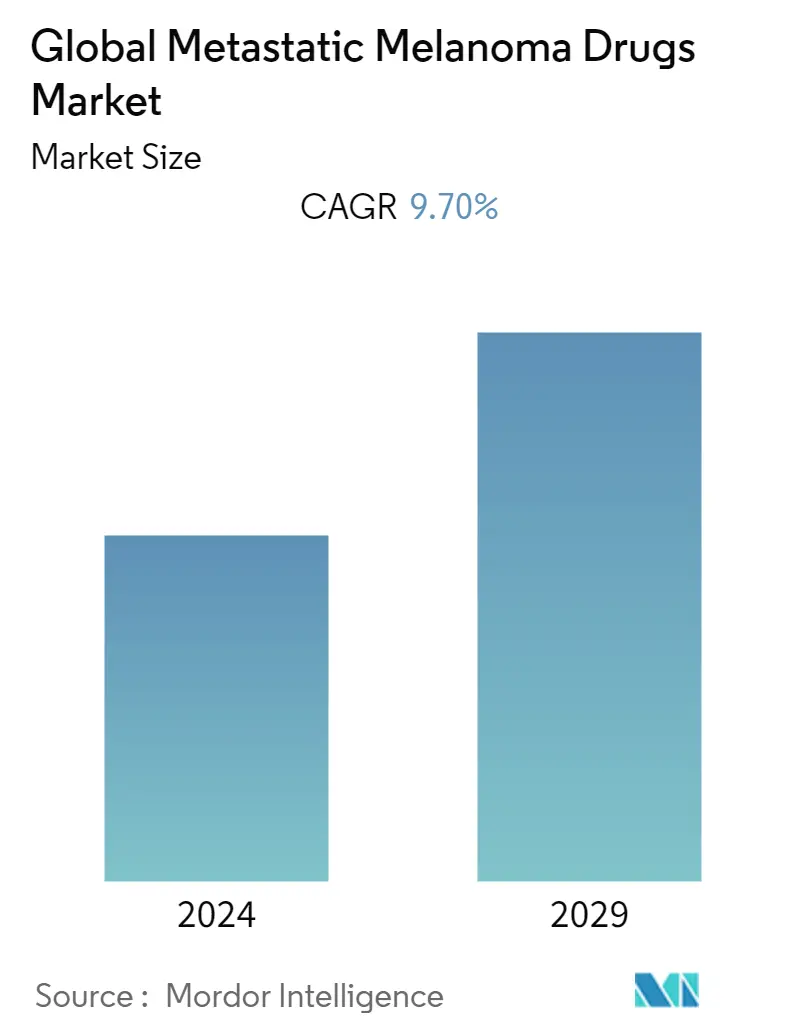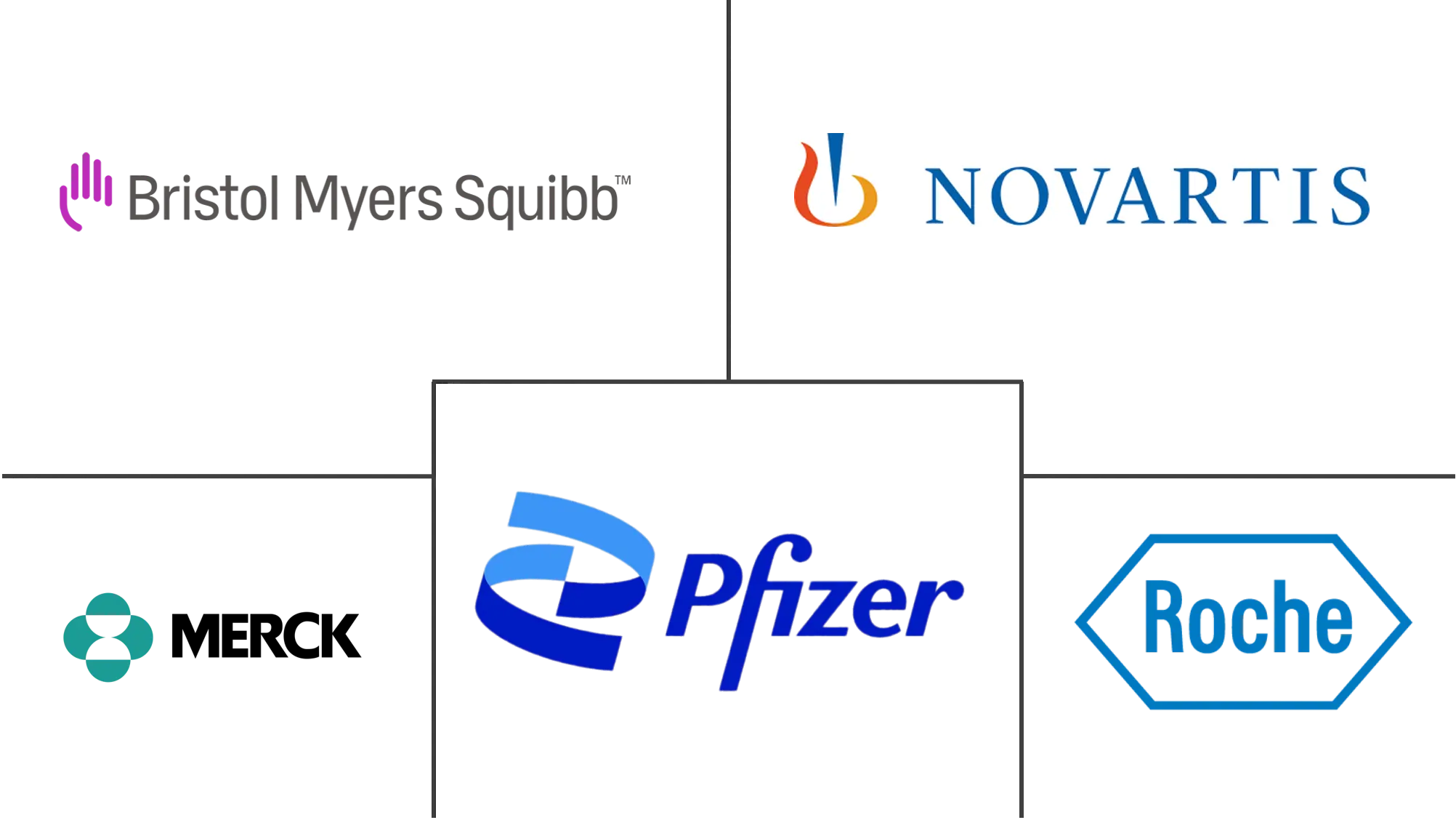Market Size of Global Metastatic Melanoma Drugs Industry

| Study Period | 2019 - 2029 |
| Base Year For Estimation | 2023 |
| Forecast Data Period | 2024 - 2029 |
| CAGR | 9.70 % |
| Fastest Growing Market | Asia-Pacific |
| Largest Market | North America |
Major Players
*Disclaimer: Major Players sorted in no particular order |
Metastatic Melanoma Drugs Market Analysis
The metastatic melanoma drugs market is expected to register a CAGR of 9.7% over the forecast period, 2022-2027.
COVID-19 pandemic has had a substantial impact on the metastatic melanoma drugs market initially. The strict lockdowns and government regulations intended to slow down the spread of COVID-19 resulted in a decrease in the treatment of cancer patients in hospitals and clinics, which includes metastatic melanoma patients as well. However, the sales of home-use metastatic melanoma drugs observed a significant increase during the pandemic. For instance, a cohort study was conducted for evaluating the impact of the covid-19 pandemic on melanoma and non-melanoma skin cancer inpatient treatment in Germany. It was published in May 2022 in the Journal of the European Academy of Dermatology and Venereology (JEADV) and the results of the study showed that since the beginning of the pandemic there has been a significant drop in the number of hospital admissions and surgical procedures for skin cancer patients. Furthermore, according to the article titled 'Melanoma Management during the COVID-19 Pandemic Emergency: A Literature Review and Single-Center Experience' published in the journal of National Center for Biotechnology Information (NCBI) in December 2021, a case study was performed where they compared the early diagnosis rate of melanoma in 2020 to that of 2018 and 2019 and a decrease in the early diagnoses of melanoma was observed during the pandemic; however, surgical interventions and systemic treatments for advanced cases were guaranteed. Thus, the COVID-19 outbreak affected the market's growth adversely in its preliminary phase; however, the market is expected to gain traction as the pandemic subsides eventually.
Further, the increasing incidence of metastatic melanoma, technological advancements for the treatment of metastatic melanoma and rising development of new biologics are among the major factors driving the growth of the studied market. Currently, factors such as rising exposure to ultraviolet rays, rising depletion of the ozone layer and increasing working hours in airplanes are also responsible for the increasing incidence of metastatic melanoma cases. Such factors are likely to boost the usage of metastatic melanoma drugs, thereby contributing to the studied market growth.
Moreover, according to an article titled 'Epidemiology of Melanoma' published in the journal of National Centre for Biotechnology Information (NCBI) in October 2021 worldwide incidence of melanoma has risen over the past few decades. The Annual incidence of melanoma is rising at a rapid rate of 4-6% in white-skinned populations in regions like North America, Europe, Australia, and New Zealand. Furthermore, according to the American Cancer Society, Inc. by the end of the year 2022 there will be 99,780 new cases of melanoma, and 7,650 people are expected to die due to melanoma in the United States. Therefore, the use of drugs that will be used to treat the patients affected with metastatic melanoma is poised to accelerate the metastatic melanoma drugs market globally and is expected to increase in the future, thereby driving the growth of the studied market over the forecast period.
In addition, new product launches and strategic activities by major players in the market are positively affecting the growth of the studied market. For instance, in June 2022 Immunocore collaborated with Sanofi to evaluate Sanofi's product candidate SAR444245, non-alpha IL-2, in combination with Kimmtrak in patients with metastatic cutaneous melanoma. Additionally, in April 2022 Pfizer Inc. offered an independent medical education grant for the best practices in the clinical management of patients with BRAF-mutant metastatic melanoma. Thus, owing to the launches and partnerships the studied market is further expected to have significant growth over the forecast period.
Therefore, owing to the aforementioned factors the studied market is anticipated to witness growth over the analysis period. However, the high risk of side effects associated with the treatment procedure and high cost of treatment are likely to impede market growth.
Metastatic Melanoma Drugs Industry Segmentation
As per the scope of the report, metastatic melanoma is a disease that occurs when the cancerous cells from the original tumor (primary tumor) get loose, spread by traveling through the lymph or blood circulation, and start a new tumor (metastatic tumor) somewhere else. The metastatic melanoma drugs are used to treat patients who are suffering from this advanced stage of melanoma. The metastatic melanoma drugs market is segmented by drug type (chemotherapy drugs, immunotherapy drugs, and targeted therapy drugs), end-user (hospitals, specialty clinics, and other end-users), and Geography (North America, Europe, Asia-Pacific, Middle East and Africa, and South America). The market report also covers the estimated market sizes and trends for 17 different countries across major regions, globally. The report offers the value (in USD million) for the above segments.
| By Drug Type | |
| Chemotherapy Drugs | |
| Immunotherapy Drugs | |
| Targeted Therapy Drugs |
| By End-User | |
| Hospitals | |
| Specialty Clinics | |
| Other End-Users |
| Geography | ||||||||
| ||||||||
| ||||||||
| ||||||||
| ||||||||
|
Global Metastatic Melanoma Drugs Market Size Summary
The metastatic melanoma drugs market is poised for significant growth, driven by an increasing incidence of the disease and advancements in treatment technologies. The market experienced initial setbacks due to the COVID-19 pandemic, which led to a decrease in hospital treatments but saw a rise in home-use drug sales. As the pandemic's impact wanes, the market is expected to recover and expand, fueled by factors such as rising ultraviolet exposure and ozone layer depletion. The development of new biologics and immunotherapy drugs, which enhance the immune response against cancer, is also contributing to market growth. These therapies offer advantages over traditional treatments by minimizing side effects, thereby increasing their adoption among patients.
North America is anticipated to lead the market due to the availability of advanced drugs and high awareness levels among patients. The region's growth is supported by robust research and development activities and the presence of major market players. The competitive landscape is fragmented, with several global and regional companies like Bristol-Myers Squibb, Merck & Co., and Pfizer Inc. holding significant market shares. Strategic collaborations and product launches are further propelling market expansion. Despite challenges such as high treatment costs and potential side effects, the market is expected to witness promising growth, particularly in the immunotherapy segment, which is gaining traction due to its efficacy in treating metastatic melanoma.
Global Metastatic Melanoma Drugs Market Size - Table of Contents
-
1. MARKET DYNAMICS
-
1.1 Market Overview
-
1.2 Market Drivers
-
1.2.1 Increasing Incidence of Metastatic Melanoma
-
1.2.2 Technological Advancements for The Treatment of Metastatic Melanoma
-
1.2.3 Rising Development of New Biologics
-
-
1.3 Market Restraints
-
1.3.1 High Risk of Side Effects Associated with the Treatment Procedure
-
1.3.2 High Cost of Treatment
-
-
1.4 Porter's Five Force Analysis
-
1.4.1 Threat of New Entrants
-
1.4.2 Bargaining Power of Buyers/Consumers
-
1.4.3 Bargaining Power of Suppliers
-
1.4.4 Threat of Substitute Products
-
1.4.5 Intensity of Competitive Rivalry
-
-
-
2. MARKET SEGMENTATION (Market Size by Value - USD million)
-
2.1 By Drug Type
-
2.1.1 Chemotherapy Drugs
-
2.1.2 Immunotherapy Drugs
-
2.1.3 Targeted Therapy Drugs
-
-
2.2 By End-User
-
2.2.1 Hospitals
-
2.2.2 Specialty Clinics
-
2.2.3 Other End-Users
-
-
2.3 Geography
-
2.3.1 North America
-
2.3.1.1 United States
-
2.3.1.2 Canada
-
2.3.1.3 Mexico
-
-
2.3.2 Europe
-
2.3.2.1 Germany
-
2.3.2.2 United Kingdom
-
2.3.2.3 France
-
2.3.2.4 Italy
-
2.3.2.5 Spain
-
2.3.2.6 Rest of Europe
-
-
2.3.3 Asia-Pacific
-
2.3.3.1 China
-
2.3.3.2 Japan
-
2.3.3.3 India
-
2.3.3.4 Australia
-
2.3.3.5 South Korea
-
2.3.3.6 Rest of Asia-Pacific
-
-
2.3.4 Middle East and Africa
-
2.3.4.1 GCC
-
2.3.4.2 South Africa
-
2.3.4.3 Rest of Middle East and Africa
-
-
2.3.5 South America
-
2.3.5.1 Brazil
-
2.3.5.2 Argentina
-
2.3.5.3 Rest of South America
-
-
-
Global Metastatic Melanoma Drugs Market Size FAQs
What is the current Global Metastatic Melanoma Drugs Market size?
The Global Metastatic Melanoma Drugs Market is projected to register a CAGR of 9.70% during the forecast period (2024-2029)
Who are the key players in Global Metastatic Melanoma Drugs Market?
Bristol-Myers Squibb Company, Pfizer Inc., Novartis AG, Merck & Co., Inc. and F. Hoffmann-La Roche Ltd are the major companies operating in the Global Metastatic Melanoma Drugs Market.

